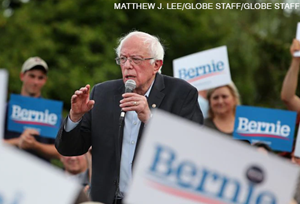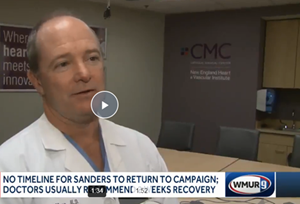From the Union Leader
Presidential hopeful Bernie Sanders could be back on the campaign trail in a few weeks, after undergoing a cardiac procedure Tuesday night — but he may have to change his lifestyle, according to a top cardiologist at the New England Heart & Vascular Institute.
Dr. Louis Fink, executive medical director at Catholic Medical Center’s NEHVI, said Sanders is now considered a cardiac patient, after two stents were placed in an artery to relieve a blockage.
The fiery Vermont senator experienced what a campaign adviser called “chest discomfort” during an appearance Tuesday evening in Las Vegas and was taken to a local hospital, where he underwent the cardiac catheterization procedure. A campaign adviser said all campaign events are cancelled “until further notice.”
Sanders was campaigning in New Hampshire on Sunday and Monday, including stops Monday in Hooksett and Manchester. Had he been stricken here, he might have ended up at NEHVI, a nationally recognized center of excellence for cardiovascular care.
 Sanders sent out a message via Twitter late Wednesday afternoon, thanking supporters for their well wishes: “I’m feeling good. I’m fortunate to have good health care and great doctors and nurses helping me to recover. None of us know when a medical emergency might affect us. And no one should fear going bankrupt if it occurs. Medicare for All!”
Sanders sent out a message via Twitter late Wednesday afternoon, thanking supporters for their well wishes: “I’m feeling good. I’m fortunate to have good health care and great doctors and nurses helping me to recover. None of us know when a medical emergency might affect us. And no one should fear going bankrupt if it occurs. Medicare for All!”
These days, recovery from a stent procedure is fairly quick, Fink said, with the patient going home either the same day or the next day. “We generally tell people not to do extreme physical activity for a week or two, but there’s not a huge recuperation from the stent per se,” he said.
Key to how long Sanders will have to stay off the campaign trail is whether he actually had a heart attack that caused damage, Fink said.
“If he didn’t have a heart attack, they might say take off a week, just because, and then they’ll have him back on the trail,” he said.
But if he did suffer a myocardial infarction with heart damage, he said, doctors likely will recommend a longer recuperation period, with cardiac rehab.
The real issue, Fink said, is Sanders’ underlying medical condition, atherosclerosis, sometimes called hardening of the arteries, a buildup of plaque in the arteries. He compares it to a “sick pipe.”
“If you actually opened up that pipe, there’s not just one spot that’s corroded. There’s one critical spot, but the rest of the pipe very well has some degree of corrosion,” he said “And that’s true of the heart arteries too.”
A stent acts like a spot weld, he said. “But the thing you really want to emphasize is that having a stent is not a cure,” he said. “This is a disease process.”
And while the extent of blockages in other arteries is unknown, he said, “It is unusual to have blockage in one artery and have the other arteries pristine.”
When the senator arrived in the emergency room, he would have undergone blood tests and an EKG to see if he was having a heart attack, Fink said. If those tests showed something abnormal, or if Sanders was continuing to have chest pain, he would have been sent to the cardiac cath lab.
“We don’t really know what caused them to pull that trigger,” Fink said.
But here’s what would happen next: A tiny tube is inserted in the radial artery of the right wrist and threaded up into the aorta. Dye is injected and an X-ray determines whether there is a blockage.
If a “tight” blockage is detected, Fink said, a tiny metal stent is inserted through another tube to the site of the blockage. A balloon inside the stent is inflated, expanding the stent into the targeted area, and the balloon is then deflated and removed, leaving the stent behind and the artery opened. “It’s like a metal scaffold that props up the artery,” Fink explained.
Doctors typically put cardiac patients on a statin medication to lower cholesterol, and strongly advise them to stop smoking, exercise and eat a healthy diet, Fink said. It’s what cardiologists call “risk factor optimization,” he said.
Stent patients also are put on dual anti-platelet therapy, a combination of aspirin and a blood thinner.
It’s not like the old days, Fink said, when a 78-year-old heart patient would have been sent “out to pasture.”
“The goal is to get people back to doing exactly what they were doing before this event,” he said. “With a proviso that you have to do the right things.”
“You see what those candidates eat, and you cringe,” he added.
By adopting healthy habits, Sanders “could be a model for the country,” Fink said. “I would make sure that all of his other risk factors were optimized, but nothing that we have heard would make you say, ‘Your run is over.’”
If Sanders were his patient, Fink said, he would probably schedule a stress test in a few weeks, ”just to prove that he can do whatever he wants to do.”
But Sanders’ medical condition could actually work in his favor, Fink said. Most people with coronary artery disease aren’t even aware their arteries are blocked, he said. “Here’s Bernie Sanders: We know what his arteries look like, we put a stent in, and he goes on with life,” he said.